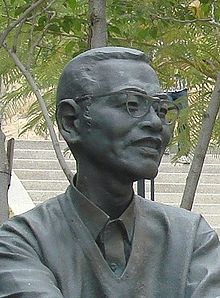- Chen's theorem
-
Chen's theorem states that every sufficiently large even number can be written as the sum of either two primes, or a prime and a semiprime (the product of two primes). The theorem was first stated by Chinese mathematician Chen Jingrun in 1966,[1] with further details of the proof in 1973.[2] His original proof was much simplified by P. M. Ross.[3] Chen's theorem is a giant step towards the Goldbach conjecture, and a remarkable result of the sieve methods.
Chen's 1973 paper stated two results with nearly identical proofs.[2]:158 His Theorem I, on the Goldbach conjecture, was stated above. His Theorem II is a result on the twin prime conjecture. It states that if h is a positive even integer, there are infinitely many primes p such that p+h is either prime or the product of two primes.
Ying Chun Cai proved the following in 2002:[4]
There exists a natural number N such that every even integer n larger than N is a sum of a prime less than or equal to n0.95 and a number with at most two prime factors.
Notes
- ^ Chen, J.R. (1966). "On the representation of a large even integer as the sum of a prime and the product of at most two primes". Kexue Tongbao 17: 385–386.
- ^ a b Chen, J.R. (1973). "On the representation of a larger even integer as the sum of a prime and the product of at most two primes". Sci. Sinica 16: 157–176.
- ^ Ross, P.M. (1975). "On Chen's theorem that each large even number has the form (p1+p2) or (p1+p2p3)". J. London Math. Soc. (2) 10,4 (4): 500–506. doi:10.1112/jlms/s2-10.4.500.
- ^ Cai, Y.C. (2002). "Chen's Theorem with Small Primes". Acta Mathematica Sinica 18 (3): 597–604. doi:10.1007/s101140200168.
References
- Nathanson, Melvyn B. (1996). Additive Number Theory: the Classical Bases. Graduate Texts in Mathematics. 164. Springer-Verlag. ISBN 0-387-94656-X. Chapter 10.
- Wang, Yuan (1984). Goldbach conjecture. World Scientific. ISBN 9971-966-09-3.
External links
- Jean-Claude Evard, Almost twin primes and Chen's theorem
- Weisstein, Eric W., "Chen's Theorem" from MathWorld.

This number theory-related article is a stub. You can help Wikipedia by expanding it.

